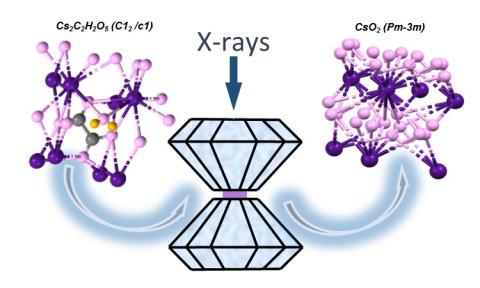Synthesis of cesium superoxide via monochromatic X-rays with high pressure assistance
A recent study published in Physical Chemistry Chemical Physics reports on synthesis of cesium superoxide via monochromatic X-ray induced decomposition of cesium oxalate monohydrate at high pressure (HP). The work was a collaborative effort, led by Assistant Research Professor Egor Evlyukhin and graduate student Petrika Cifligu with Profs. Michael Pravica and Pradip K. Bhowmik from UNLV, and contributions from Prof. Eunja Kim at UTEP and HPCAT-colleagues Dmitry Popov and Changyong Park. A primary contribution of this work was the demonstration that a combination of X-rays with high pressure assistance can be considered as a new route for chemical and structural synthesis. The publication has been selected by the Editors as a 2023 HOT PCCP article.
Since the beginning of the 20th century, X-ray radiation has been widely utilized for analysis of the electronic and structural properties of matter. However, the high proclivity of X-rays to ionize and destabilize atomic/molecular entities via activation of electronic relaxation processes induces damage in matter. Essentially, absorption of sufficiently energetic X-ray photons by a molecular system results in a cascade of ultrafast electronic relaxation processes which leads to a distortion and dissociation of its molecular structure. A strong dependence of the type and efficiency of electronic relaxation processes on the chemical environment, initial charge states of atomic entities, atomic/molecular spatial separation and X-ray energy suggest that X-ray induced damage can be controlled and even directed toward synthesis of novel compounds by a special selection of initial conditions.
In this study, a team of scientists experimentally demonstrated that a combination of high pressure and the presence of water molecules in initial solid-state compounds plays a crucial role for X-ray induced structural and chemical synthesis. In comparison, when unhydrated cesium oxalate (Cs2C2O4) at ambient and high pressure was subjected to monochromatic X-ray irradiation, only the distortion of the electron density distribution was observed and no formation of a novel crystalline compound was detected. On the other hand, only at high pressures, the X-ray irradiation of cesium oxalate monohydrate (Cs2C2H2O5) led to the synthesis of cesium superoxide with a bcc structure. A model of electronic relaxation processes triggered by X-ray photoabsorption in a single Cs2C2H2O5 molecule with an emphasis on the key role of water molecules was proposed from this observation. For the critical role of high pressure, it has been suggested that the reduced spatial separation between Cs cations and H2O molecules increases the rate of electron transfer decay processes, thereby magnifying the rate of X-ray induced synthesis of CsO2.
E. Evlyukhin, P. Cifligu, M. Pravica, P. K. Bhowmik, E. Kim, D. Popov, C. Park, Experimental demonstration of necessary conditions for X-ray induced synthesis of cesium superoxide, Physical Chemistry Chemical Physics, 25, 1799-1807 (2023) DOI: 10.1039/D2CP04767E.

